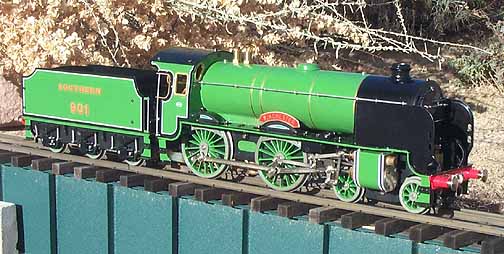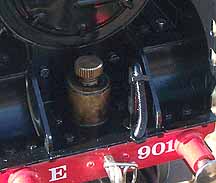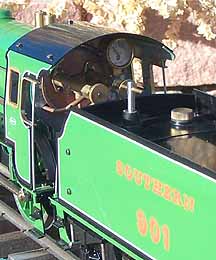
Back to Sidestreet Bannerworks
December 2001
Aster "Schools" Class 4-4-0
by Marc Horovitz

The Southern Railways "Schools" class 4-4-0 was introduced in 1930 as a passenger-hauling locomotive for the Hastings line, a route with severe gradients, lots of curves, and clearance restrictions. The 4-6-0 "King Arthur" class engines were favored at the time but were too large and heavy for the line. R.E.L. Maunsell, the Southern Railway's locomotive designer, came up with the "Schools" 4-4-0, based on both the "Lord Nelson" and "King Arthur" 4-6-0s.
The new "Schools" proved up to the task. It had three cylinders and was the largest 4-4-0 ever built in Britain or, some say, in Europe. It was developed quickly and cheaply and proved a popular and efficient engine, eventually replacing the "King Arthurs" on the Bournemouth route. During WWII they were painted black but were otherwise resplendent in SR green. Around 40 of them were produced in all.
The model
I've always considered Aster's "Schools" to be a historic model. After all, it was the first engine Aster ever produced (made simultaneously with the company's JNR 2-6-0). There were 3,000 of them made, mostly in kit form. This was a bold new step in the live-steam hobby -- kits for fully functional, scale steam locomotives that needed no machine work, drilling and tapping, paint, or finishing. Even most of the tools required for assembly were included with the kit. As with all subsequent Aster kits, instructions came in two parts: written and pictorial. In these early days, not all of the holes always aligned properly, and a set of needle files was almost a prerequisite for successful construction. The kit was a wonderful way to get to know your engine intimately.
This engine is, to me, the quintessential British, gauge-1 locomotive, not because it is a model of a British engine, but because it was designed using 1930s British gauge-1 technology. While the prototype was a three-cylindered locomotive, Aster's model has but two. It is alcohol fired, using a chicken-feed system carried in the tender, feeding a three-wick (asbestos string) burner in the firebox. It has an internally fired boiler of the simplest kind, a Smithies. This is basically a boiler tube inside an outer barrel. The fire is pulled by the blower through the outer, and around the inner barrel. The design gives large heating surface at the expense of water capacity. Fittings are basic, consisting of a pair of safety valves, a throttle, and a blower. There is also an extra plug in the backhead, to which could be fitted a check valve for filling the boiler with an external pump, or a pressure gauge. I chose the latter.
Reversing is via a slip return crank, a variation of the slip eccentric. Thus, the engine must be pushed in the desired direction to properly set the valves. A dead-leg displacement lubricator sits on the pilot deck. No drain is provided.
Aster's locomotive bears the name Winchester (all of this class were named after schools, hence the class designation). It is a pretty good model of the prototype -- not too many compromises were made. It certainly captures the feeling of the full-size engine. It looks great, with its malachite-green paint and elephant ears. These well known and much-liked engines have been repainted and modified in many different ways over the years. Some have even been fitted with coal-fired boilers. Ironically, in 1979 Aster developed its "King Arthur" 4-6-0 based on leftover "Schools" parts. Only 300 of these were made.
Performance
This is a fun engine to run. After a general lube, fill-up of steam oil, distilled water, and alcohol, I placed the suction fan in the stack and turned it on. Then I opened the fuel valve on the tender and could see the meths flowing to the engine through the clear connecting pipe. With my trusty igniter (some asbestos string tied up with a wire) soaked in alcohol, I lit the wicks and went off to wipe down the track while pressure came up.
Ambient temperature was in the 50s and the needle was off the peg in minutes. At about 20 psi I removed the fan and let the engine's blower take over. This moment is always a little magical, a little like a spacecraft throwing off all its earthbound fetters and setting out on its own. The engine comes alive at this point, making its own noises and doing what it was designed to do.
Once steam came up to blowoff pressure, I gently pushed the engine forward while opening the throttle. The condensate cleared with a few strangled coughs, and it was off, running at a brisk clip. I let it go once around the track, running light to get warmed up, then coupled it to a train of four Aster Southern Railway coaches.
With a load (the way these locomotives really should be run), the engine really came into its own. Its sharp, deep exhaust beats were loud and distinct. An alcohol-fueled engine with an internally fired boiler makes what I've always considered to be good, honest sounds. There's no roar, hiss, or whistle from a pressurized fuel system. All the sounds you hear are made by steam and machine.
With the engine pulling a train, you need only open the throttle and step back. The train slowly accelerates in a wonderfully prototypical manner until the desired speed is attained. From there it just goes and goes, the exhaust audible from any point on the line.
The Aster "Schools" with a train of coaches makes an impressive sight, running over bridges and through stations at perhaps a scale 60 mph, safety valve blowing and exhaust steam blasting into the cool air. What could be finer? It is the easiest thing to imagine the train hurtling through the English countryside (albeit in Colorado!).
| Specifications | |
| Builder | Aster Hobby Company, Japan |
| Date built | 1975 |
| Gauge | 45mm (gauge 1) |
| Scale | 1:32 |
| Boiler | Smithies |
| Fittings | Throttle, blower, pressure gauge (not standard), two safety valves |
| Fuel | Alcohol, chicken-feed system in tender |
| Blow-off pressure | 45 psi |
| Cylinders | Two, double acting, D-valve |
| Reversing gear | Slip return crank |
| Lubricator | Displacement |
| Dimensions | Length over end beams (incl. tender), 20-3/4"; width, 3-1/4"; height over stack, 5" |




Above right: The lubricator on the pilot deck is easily accessible, if a bit of an eyesore.
Right: The backhead on Aster's model is spartan. Throttle on the left and blower valve on the right. A pressure gauge has been fitted as well. On the tender, the knob on the right is the filler cap for the meths. The control valve is on the left.



Back to Sidestreet Bannerworks
This page and its contents Copyright Sidestreet Bannerworks, 2001